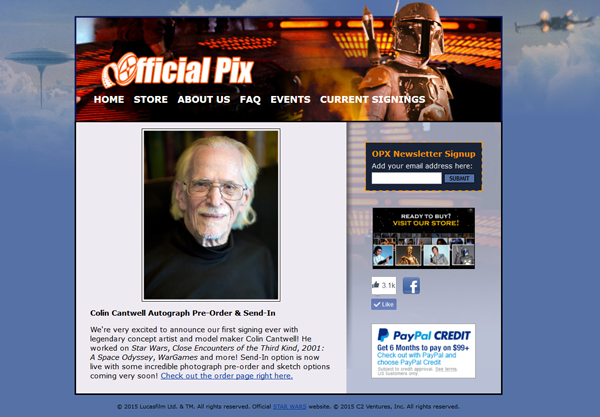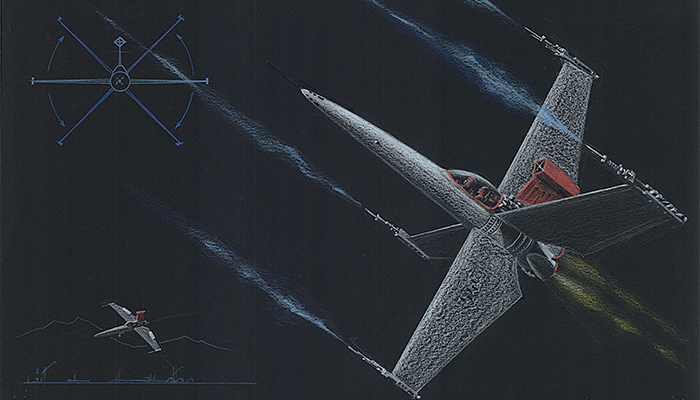Official Pix is offering their first signing opportunity to get autographs and personalized sketches from Colin Cantwell. At 82 years old today, Colin Cantwell famously made the first prototype models for the first Star Wars films for George Lucas back in 1974/1975; the first realizations for the X-Wing Fighter, the Y-Wing Fighter, the Tie Fighter, the Star Destroyer, the Death Star, the Landspeeder, the Sandcrawler, and the Millennium Falcon, as well as the T-16 Skyhopper that Mark Hamill is seen using in the final cut of the film. Prior to building these prototype models, Colin created original full color artwork as well as sketches based on his discussions with George Lucas in 1974, and was one of the very first artists to work on Star Wars. I worked with Mr. Cantwell in 2014, helping him to bring some rare memorabilia to auction with Julien’s Auctions as well as recording a number of video interview with him about his work in and out of the film and television industries (see all Original Prop Blog articles about Colin Cantwell here: LINK).
The signing opportunity offered by Official Pix is coming up in just a few weeks, so check out their official site for all of the details on how to participate at www.OfficialPix.com:

Colin Cantwell, both a computer and space movie pioneer, was instrumental advancing technology to the cutting edge.
Colin’s career began in 1955 when he attended the University of California Los Angeles as an art and engineering major. After suggesting that UCLA add an animation major to their curriculum, Colin then became the first animation graduate from the University.
While at UCLA, after listening to a Buckminster Fuller seminar, Colin spent 3 days analyzing the content to determine what Bucky Fuller might have missed. As a result, Colin developed the concept of Cosmic Biodesics. Today, Colin is still working on cutting edge developments in this area.
A few years later Colin joined Hewlett Packard where he designed 36 demos with interactive graphic applications and 5000 colors that took Hewlett Packard from green computer screens into the world of color computer graphics
His next adventure was working as a public information liaison at NASA. In this role Colin created TV animation for each new mission to Mars, Venus and following planets.
1968 took Colin to England where he worked on the film, “2001 A Space Odyssey”. During a midnight snack at Stanley Kubrick’s home, a frustrated Kubrick told Colin that he had replaced his fourth composer and still was not satisfied with the music. Colin then suggested that Kubrick go for a memorable opening with the music “Also sprach Zarthustra” by Richard Strauss. Colin also suggested the compositions of Adagio by Aram Kachaturian and Atmospheres by Gyorgy Ligeti.
In addition, Colin designed the title scenes and managed the completion of the animation for the last 3 months of production.
In 1973, at the Ruben H. Fleet Space Theater Planetarium, in San Diego, Colin wrote, designed and directed the first OMNIMAX spherical projection movie, “Journey to the Outer Planets”. OMNIMAX is now known as IMAX.
Colin’s most notable contribution to the film industry was working closely with George Lucas on the space ship designs for the original 1977 Star Wars film (now known as Episode IV: A New Hope) This includes the design of the X Wing, Y Wing, Tie Fighter and the Death Star. In addition, in pre-production discussions, he outlined his vision for some of the fighting scenes including the dramatic battle scene in the Death Star trench.
For “Close Encounters of a Third Kind”, Colin presented Steven Spielberg with his vision of the first scene design of the hovering alien ship. Doug Trumball then became responsible for designing the scenes in the final movie.
Around 1979, Colin developed a revolutionary new device called an interactive motion control system. This allowed animators to more easily simulate the movements of the spacecraft during the design phase of space battles in the Buck Rogers TV Series. Colin subsequently proposed the creation of the Universal’s Hartland special effects facility.
In one of his last projects, Colin was asked to design the NORAD war room scenes for the movie “War Games”. The 12 giant War Room wall screens were programmed by Colin in a rush environment where each screen’s programming occurred the night before filming. These “large monitors” were, in fact about 6×8 inch Hewlett Packard computer monitors that were enlarged for dramatic movie effects.
One of his most memorable and important experiences was in July of 1969. At that time, Colin was positioned behind Walter Cronkite in the CBS studio while Walter gave a blow by blow description of the first Apollo 11 landing on the moon. Colin was the “Hal 9000” computer that was feeding Walter the actual flight information that was broadcast live on TV during the moon landing.
Today, at 82 years old, Colin continues to advance his Stellar Biodesics concept that he has been developing since the Buckminster Fuller seminar in 1955.
Jason DeBord

